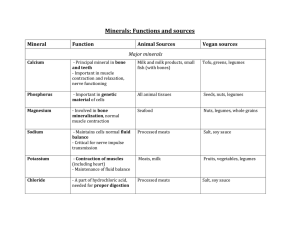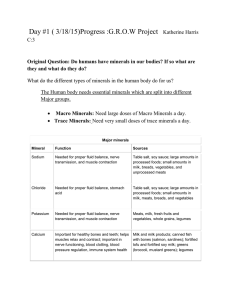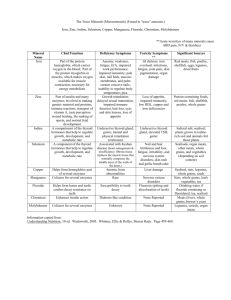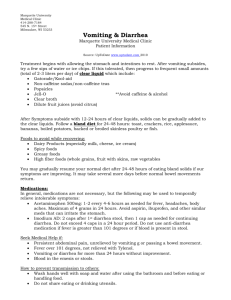Summary of Chapter 9 – Water and the Minerals
advertisement
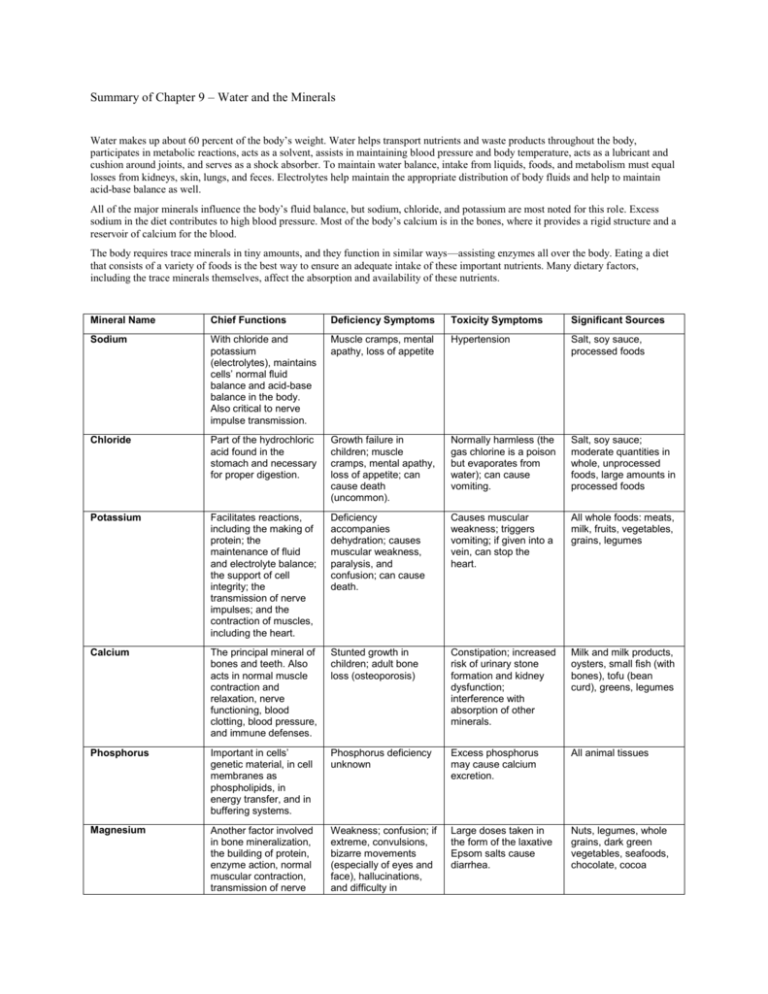
Summary of Chapter 9 – Water and the Minerals Water makes up about 60 percent of the body’s weight. Water helps transport nutrients and waste products throughout the body, participates in metabolic reactions, acts as a solvent, assists in maintaining blood pressure and body temperature, acts as a lubricant and cushion around joints, and serves as a shock absorber. To maintain water balance, intake from liquids, foods, and metabolism must equal losses from kidneys, skin, lungs, and feces. Electrolytes help maintain the appropriate distribution of body fluids and help to maintain acid-base balance as well. All of the major minerals influence the body’s fluid balance, but sodium, chloride, and potassium are most noted for this role. Excess sodium in the diet contributes to high blood pressure. Most of the body’s calcium is in the bones, where it provides a rigid structure and a reservoir of calcium for the blood. The body requires trace minerals in tiny amounts, and they function in similar ways—assisting enzymes all over the body. Eating a diet that consists of a variety of foods is the best way to ensure an adequate intake of these important nutrients. Many dietary factors, including the trace minerals themselves, affect the absorption and availability of these nutrients. Mineral Name Chief Functions Deficiency Symptoms Toxicity Symptoms Significant Sources Sodium With chloride and potassium (electrolytes), maintains cells’ normal fluid balance and acid-base balance in the body. Also critical to nerve impulse transmission. Muscle cramps, mental apathy, loss of appetite Hypertension Salt, soy sauce, processed foods Chloride Part of the hydrochloric acid found in the stomach and necessary for proper digestion. Growth failure in children; muscle cramps, mental apathy, loss of appetite; can cause death (uncommon). Normally harmless (the gas chlorine is a poison but evaporates from water); can cause vomiting. Salt, soy sauce; moderate quantities in whole, unprocessed foods, large amounts in processed foods Potassium Facilitates reactions, including the making of protein; the maintenance of fluid and electrolyte balance; the support of cell integrity; the transmission of nerve impulses; and the contraction of muscles, including the heart. Deficiency accompanies dehydration; causes muscular weakness, paralysis, and confusion; can cause death. Causes muscular weakness; triggers vomiting; if given into a vein, can stop the heart. All whole foods: meats, milk, fruits, vegetables, grains, legumes Calcium The principal mineral of bones and teeth. Also acts in normal muscle contraction and relaxation, nerve functioning, blood clotting, blood pressure, and immune defenses. Stunted growth in children; adult bone loss (osteoporosis) Constipation; increased risk of urinary stone formation and kidney dysfunction; interference with absorption of other minerals. Milk and milk products, oysters, small fish (with bones), tofu (bean curd), greens, legumes Phosphorus Important in cells’ genetic material, in cell membranes as phospholipids, in energy transfer, and in buffering systems. Phosphorus deficiency unknown Excess phosphorus may cause calcium excretion. All animal tissues Magnesium Another factor involved in bone mineralization, the building of protein, enzyme action, normal muscular contraction, transmission of nerve Weakness; confusion; if extreme, convulsions, bizarre movements (especially of eyes and face), hallucinations, and difficulty in Large doses taken in the form of the laxative Epsom salts cause diarrhea. Nuts, legumes, whole grains, dark green vegetables, seafoods, chocolate, cocoa impulses, and maintenance of teeth. swallowing. In children, growth failure. Sulfur A component of certain amino acids; part of the vitamins biotin and thiamin and the hormone insulin; combines with toxic substances to form harmless compounds; stabilizes protein shape by forming sulfur-sulfur bridges. None known; protein deficiency would occur first. Would occur only if sulfur amino acids were eaten in excess; this (in animals) depresses growth. All protein-containing foods Mineral Name Chief Functions Deficiency Symptoms Toxicity Symptoms Significant Sources Iron Part of the protein hemoglobin, which carries oxygen in the blood; part of the protein myoglobin in muscles, which makes oxygen available for muscle contraction; necessary for the utilization of energy. Anemia: weakness, pallor, headaches, reduced work productivity, inability to concentrate, impaired cognitive function (children), lowered cold tolerance Iron overload: infections, liver injury, possible increased risk of heart attack, acidosis, bloody stools, shock Red meats, fish, poultry, shellfish, eggs, legumes, dried fruits Zinc Part of the hormone insulin and many enzymes; involved in making genetic material and proteins, immune reactions, transport of vitamin A, taste perception, wound healing, the making of sperm, and normal fetal development. Growth failure in children, sexual retardation, loss of taste, poor wound healing, eye lesions leading to impaired dark adaptation Fever, nausea, vomiting, diarrhea, muscle incoordination, dizziness, anemia, accelerated atherosclerosis, kidney failure Protein-containing foods: meats, fish, shellfish, poultry, grains, vegetables Selenium Assists a group of enzymes that break down reactive chemicals that harm cells. Predisposition to heart disease characterized by cardiac tissue becoming fibrous (uncommon) Nausea, abdominal pain, nail and hair changes, nerve damage Seafoods, organ meats, other meats, whole grains and vegetables depending on soil content Iodine A component of two thyroid hormones, which help to regulate growth, development, and metabolic rate. Goiter, cretinism Depressed thyroid activity; goiter-like thyroid enlargement Iodized salt; seafood; bread; plants grown in most parts of the country and animals fed those plants. Copper Necessary for the absorption and use of iron in the formation of hemoglobin; part of several enzymes. Anemia, bone abnormalities (rare in human beings) Vomiting, diarrhea, liver damage Organ meats, seafood, nuts, seeds, whole grains, drinking water Manganese Facilitator, with enzymes, of many cell processes. (In experimental animals): poor growth, nervous system disorders, reproductive abnormalities Nervous system disorders Widely distributed in foods Fluoride An element involved in the formation of bones and teeth; helps to make teeth resistant to decay. Susceptibility to tooth decay Fluorosis (discoloration of teeth), nausea, diarrhea, chest pain, itching, vomiting Drinking water (if fluoride containing or fluoridated), tea, seafood Chromium Associated with insulin and required for the release of energy from glucose. Diabetes-like condition marked by an inability to use glucose normally None reported Meat, unrefined foods
